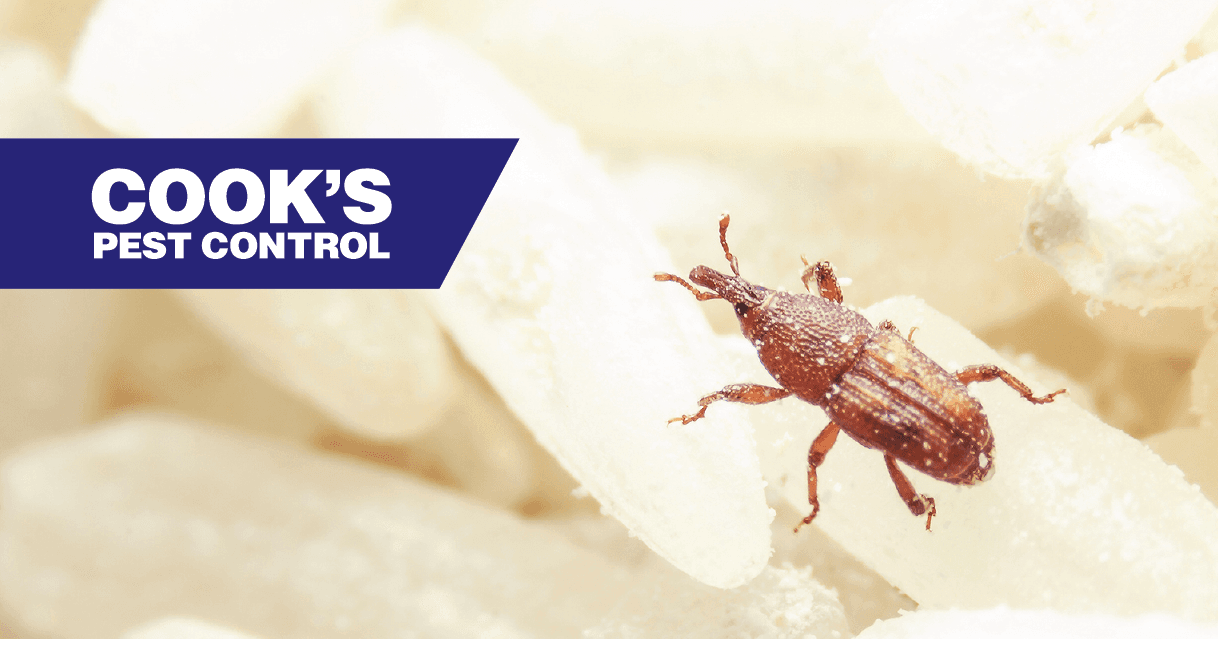Stored Product Pests: Weevils, Beetles and Moths – Oh my!

Ever open a bag of flour or rice and find something crawling around? Wonder why and how that pest invaded your kitchen pantry? There is always the chance it didn’t come into your home at all; instead, you may have bought the product with insects included. There are a few different types of such pests, commonly called stored product pests, that we encounter frequently. They are often in one of two groups of insects – beetles or moths. Despite our efforts to buy the freshest items available, sometimes these pesky insects can ruin a bag of food. These insects are primarily a concern for commercial food storage and distribution facilities, but sometimes they make it into peoples’ homes.
The Most Wanted List
Let’s look at a list of our “most wanted” stored product foes. There are many different problem insects, including the rice weevil, granary weevil, the red and confused flour beetles, cigarette beetle, drugstore beetle, and the Indianmeal moth. All of them have their own preferences for how they eat, where they eat and what they eat. Some of them are similar in appearance and are often confused with each other, so understanding their unique qualities helps in diagnosing pest problems in commercial food settings and in homes.
The rice and granary weevils are in the order Coleoptera, which is the scientific order for all beetles. These beetles are often confused with one another. They are distinguishable from other types of beetles because of the slender elongation of their heads. Because of this feature, they are often referred to as snout beetles. Both are considered internal feeders because they bore holes into grain kernels to deposit their eggs. Several features distinguish the granary weevil from the rice weevil. The granary weevil is about 1/8” long and shiny dark brown or black. Adults of this species have non-functional wings, meaning that they are unable to fly. The rice weevil, on the other hand, is a great flyer and slightly smaller. It is reddish-brown to black and usually has four reddish or yellowish spots on its elytra, or wing cases. These beetles are often found in stored grains and flour.
The second set of beetles that we commonly encounter include the red and confused flour beetles. These beetles are serious pests of flour, cereal, and broken grains. Both are very similar in appearance. Adults are about 1” long, flattened and shiny reddish-brown. Antennae are what differentiates these two pesky beetles: the antennae of the confused flour beetle terminate in four segments that gradually form a club shape, whereas the red flour beetle’s antennae abruptly terminate in three larger, clublike segments. Preferring damaged grains, flour cereal as well as other stored products, these beetles do not attack whole grains. Their small size allows them entry into closed containers that normally would be considered insect-proof.
Cigarette and drugstore beetles are the final pair of beetles that commonly cause problems in stored food products. This is another pair of similar-looking beetles; however, they both have distinctive physical characteristics and feeding habits. The cigarette beetle is reddish yellow to brownish red, approximately 1/8” long and has a distinctive humpbacked appearance. These beetles prefer to eat foods such as tobacco, rice, raisins, grains, pepper, and many other stored products. The drugstore beetle is about the same size as the cigarette beetle and reddish-brown in appearance. They can be distinguished by their longitudinal ridges and are less humped. These beetles prefer to feed on spices, drugs, books, and wood.
Finally, the last stored product pest that we often encounter is the Indianmeal moth. Moths are in the insect order Lepidoptera. This moth is a pest of coarsely ground flours, such as whole wheat flour, and cornmeal. These moths are also often found eating pet food, peanuts, dried fruit, seeds, peas, beans, biscuits, powdered milk, and many other commodities. Have you ever gone to a roadhouse that has peanuts on the table and see moths flying around the restaurant? More than likely they are these guys. They are also widespread in grocery stores, warehouses, and kitchens. Moths have a wingspan of about 3/4”, and their wings are pale gray with the outer two-thirds of the forewing colored reddish-brown with a coppery luster.
All of these pests can be found in both commercial and residential settings, so how do we help get rid of them? Sanitation and exclusion are two of the most important methods of control. These pests will often find their way inside because of the spilled product, and, once inside, will find a cozy place to eat and rest. Making sure that spilled food is cleaned up is vital. As for exclusion, it is important to keep food in air-tight containers. Even though some of these pests will find their way into such containers sometimes, it is one of the best methods for pest prevention. Other exclusion methods can be used to seal up homes and businesses from potential insect invaders. Make sure that all doors have good door sweeps, windows are well sealed, lights are away from homes and buildings if possible (to prevent attracting insects) and use screening as much as necessary. Another way to help eliminate these is using the FIFO, short for “first in, first out,” method. This is a standard practice among food distributors and grocery stores, and you can use it in your home as well. Basically, using the FIFO method means that you should use up all your oldest food first. The longer the food sits in your home, the more susceptible it will become to pest activity. Monitor your stored foods, and be careful not to let an old bag of flour sit too long in the depths of your pantry! These pests are manageable and preventable by being as attentive as possible to your pantry.
-Kristen Stevens, BCE
